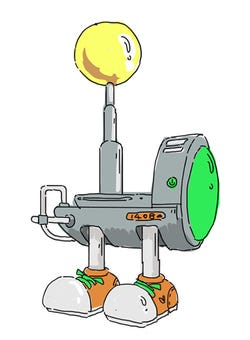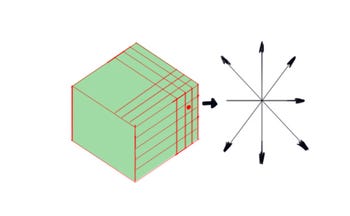Impression of VR Louvre Museum
In this series, I share with you my experience of visiting the most exciting VR museums in the world.This is Part 2 of the series.

Please Note: this series is written in 2020.

I love traveling around the world in my computer. 10 years ago, I would spend hours on Google map, visiting the great cities in panorama mode. And now it’s exciting to learn that many great museums in the world offer online VR version. Wow, my favorite sites in cities are museums, now I can see them all at nearly no cost!
I have visited so many VR museum in the last few weeks, among them, two give me the deepest impression.
The Louvre
Last month, my good friend Elise messages me and many other friends, that the Louvre has a major update on their online VR museum, if someone wishes to visit with her in the weekend.
“It’s fantastic! ” She couldn’t conceal her excitement. Elise is a professional 3D artist, and has been art director of many AAA VR games. And her hometown is Paris, she’s so proud of the museum. If she says it’s great, it must be something.
And in my eyes the Louvre is unique. For most of the museum in the world, they just display the paintings and sculptures in simple rooms. But for Louvre, it had been a royal palace, with richly decorated interiors and so much history, it’s hard to draw a line between the collections and the backdrop, the mansion itself is an artwork.

For this sake, in last few decades, the Louvre has strived hard to present a VR museum which is true to its intrinsic values. And I have visited a few versions, I can only say that technology still has long way to go.
On the designated day, I log into the VR museum. I find Elise and a small group of friends gather below the famous pyramid. I know Elise pretty well, in her style she would like to guide us to the Grand Gallery, and give long comments on French art, which I couldn’t quite understand. But quite unexpected, Elise has us jump to a few spots in teleport mode, “I want you guys to have an overview of the new VR museum!” She says.
And it’s indeed mind boggling experience. First of all, all the collections and interior look just of the same degree of realism of the real site. I’m a professional photographer, my eyes are very picky. For this one I could say it’s no high resolution 3D recreation - Only God can cast lights in such rich and subtle way.
And the connection of the whole interior is physically accurate. You can enter the chambers to the left hand of the Victory of Samothrace, turn right, enter the Grand Gallery, and then go a few steps further to find Mona Lisa on your right.
There are many moving modes, which make browsing the museum easy: You can walk by your feet, aided by some accessories such as Google Walker; You can move in Wheel mode, that it’s like sitting on an electric wheelchair, you can move swiftly by pressing buttons; And the most awesome features is teleportation, you can move to any major spots of the museum instantaneously. You know in the past, if you want to move from Napoleon’s Apartments to Denon, it would take you half an hour to walk in both wings of the building.
So when Elise points to the Louis XIV’s portrait, showing us the slightly bumping strokes during her long discourse. I can’t help to ask, “My head is full, Elise, you must tell me the truth… Everything I see is real, yet they are fully interactive. ”
“Yes!”
“The only explanation is that they use the same solution as the National Museum of China (see my last article), they run droits/drones in the actual museum then synch the drone camera to the vistor’s.”

“No No, think about the full interactive features here, that type of physical solution won’t work.”
She raises her hand, “Ok, if anyone is interested in the mysteries of the museum, follow me to the projection room.”
There we see a short hologram movie about the VR Louvre, that what in use now is no 3D modeling, no laser scan, no nothing. It’s a new stuff called Matrix Photography.

First of all, a space is defined inside of the museum, which is the space that the visitor’s head could possibly reach. Then a moving camera with a spherical sensor would go over this space in scanning manner, to record all the light info inside this space.

We know, for a 2D image, it’s divided in tiny squares called pixels, each pixel stores the HSV value; A Matrix Photograph file is quite the same, it divides the 3D space into small cubes. At each cube, info of all the light rays coming and going through it is stored, HSV, light direction vector, etc. So when you’re inside of the space with your VR goggle, at each spot, the light matrix would be instantly read and focus to your retina to form images.

So essentially what we’re looking at is a giant Matrix photo of the Louvre, that is why it couldn’t feel more real. It’s a bit like hologram, but different.
With the Matrix Photography technology, what a museum can display, is not limited by the size of its tiny halls. By the time we visit, there is a Classic Ship Exhibition. It displays many famous ships in real size, May Flower, HMS Erebus. For those ships are lost in history, what we see is Matrix Photographed on movie sets. Yes they can be built by 3D modeling, however to get to such height of realism, the production cost would be sky high.

And sorry to discuss so much about the technique things, I almost forgot to introduce the real big thing of the new VR Louvre. You know due to the limited display space, the museum is never able to show more than 10% of its complete collections. Now a new mansion is added to the old Rechelieu, Sulley and Denon. It’s called Laputa, home to the artifacts which the real museum is unable to display.
Laputa is the real virtual portion of the museum. The architecture is created by conventional 3D technology, I can see in places the text “Powered by Unreal Technology”. In comparison to the Matrix Photographed palaces, the interior here looks much less real. Feel like in an AAA game. The interior design largely follows the old Louvre, in style from Middle Ages up to Napoleon’s time. And a touch of fantasy is added. All the all, it looks fabulous to people less nitpicking than me, and the construction cost surely is much less than a mansion in mortar & bricks.

And the artworks and artifacts in display are reproduced by Matrix Photography, to give them the maximum degree of realism. Seen as a whole, Laputa is a interlocked system of towers and corridors, shaped like a giant castle, pretty much like the sky city in the eponymous Ghibli movie. The display space is twice as big as the old museum. And it’s rumored that Laputa houses half of Louvre’s collections.
The old Louvre has a great collection of artworks from France, Italy, ancient Egypt,and Greece, however they don’t have much from the Far East. Now Laputa has dedicated a space as big as Sully to ancient Chinese and Japanese artworks. There are even full oriental gardens in display. The colors and mood is enchanting, only if you can smell the freshness of the plants! I believe those are Matrix Photographed in Japan.

I can see lots of artifacts don’t belong to Louvre, it’s apparent Louvre has borrowed the digital copies to enrich its portfolio. So if you have visited the old Louvre many times, the real meat is in Laputa.
Now I start to wonder, that the Louvre, Da Vinci’s works, and the magnificent palaces around the world may eventually be destroyed in wars, natural disasters. Perhaps thousand generations from now, they only exist in this digital form.
If you like this post, please see more of my articles and follow me here...
I would post regularly--about game and art production.
Read more about:
BlogsAbout the Author
You May Also Like









